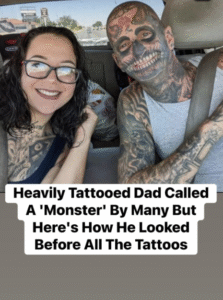The Man Behind the Ink: A Father Called a ‘Monster’ and the Story Beneath the Surface
Before the tattoos, Richard looked like any other young man—clean-shaven, soft-eyed, and quietly confident. His face was untouched, his skin a blank canvas. He wore jeans and T-shirts, smiled easily, and blended into crowds. But beneath that ordinary exterior was a man searching for something more: a way to express his identity, his love for his children, and his place in the world.
Today, Richard is covered in over 240 tattoos. His face alone bears the lips of his daughter, the footprints of his children, their names, and even an inked mouth that stretches across his chin. His transformation is striking, unapologetic, and deeply personal. Yet for many, it’s been met with judgment. He’s been called a “monster,” a “bad parent,” and worse—by strangers who see only the ink, not the man beneath it.
But Richard’s story is not one of rebellion or shock value. It’s a story of devotion, artistry, and the courage to live authentically.
A Canvas of Fatherhood
Richard’s tattoos aren’t random. They’re a living tribute to his children. Each design carries meaning—a memory, a milestone, a moment of love. The lips on his cheek? His daughter’s kiss. The footprints? Taken from the day his son was born. The names? Etched in ink so they’ll never fade.
For Richard, tattoos are not decoration. They’re devotion. “I wanted to carry my kids with me everywhere,” he’s said. “Not just in my heart, but on my skin.”
This sentiment is echoed by his wife, who also has tattoos and shares his passion for body art. Together, they’ve built a life rooted in love, creativity, and mutual respect. Their children adore them. Their home is filled with laughter. And yet, the outside world often sees only the ink.
The Price of Visibility
Richard’s appearance has made him a target. Online trolls call him a “monster.” Strangers stare in public. Some parents have even pulled their children away from him at playgrounds, assuming danger where none exists.
“It’s heartbreaking,” Richard admits. “People don’t ask questions. They just judge.”
This kind of prejudice isn’t new. Society has long associated tattoos—especially facial ones—with criminality, aggression, or deviance. But these assumptions are outdated. Today, tattoos are a form of art, identity, and storytelling. And for Richard, they’re a way to honor what matters most.
Still, the stigma persists. And it raises a deeper question: Why are we so quick to judge what we don’t understand?
Before the Ink
Photos of Richard before his transformation reveal a gentle-looking man with a quiet smile. He worked a regular job, spent weekends with his family, and lived a life that many would call “normal.” But he felt incomplete. The ink was not a rejection of who he was—it was an evolution.
“I didn’t change overnight,” he says. “Each tattoo was a step toward becoming who I really am.”
His journey began with small designs—symbols of his children, tributes to loved ones. Over time, the tattoos grew bolder, more visible. His face became part of the canvas. And with each new piece, he felt more whole.
The transformation was physical, yes—but also emotional. Richard found confidence, clarity, and a sense of purpose. He wasn’t hiding behind the ink. He was revealing himself.
Parenting Beyond Appearances
Despite the criticism, Richard is a devoted father. He attends school events, helps with homework, and plays with his kids in the backyard. His children don’t see a “monster.” They see Dad.
“They love my tattoos,” he says. “They know what each one means. They helped pick some of them.”
His parenting style is rooted in openness and honesty. He teaches his children to be kind, curious, and unafraid of difference. He encourages them to ask questions, challenge assumptions, and embrace who they are.
In many ways, Richard’s appearance has become a teaching tool. His children have learned firsthand that love isn’t skin-deep—and that judgment says more about the person casting it than the one receiving it.
The Courage to Be Seen
Richard’s story is a reminder that self-expression takes courage. It’s easy to conform, to blend in, to avoid scrutiny. But living authentically—especially when it defies norms—requires strength.
He could have stayed the man in the “before” photo. He could have avoided the stares, the comments, the cruelty. But he chose to be himself. Fully, visibly, unapologetically.
And in doing so, he’s become a symbol—not of rebellion, but of resilience.
A Call for Compassion
The judgment Richard faces is not unique. Many people who look “different”—whether through tattoos, piercings, disability, race, or gender expression—encounter bias. They’re stared at, whispered about, excluded.
But difference is not danger. And appearance is not character.
Richard’s story challenges us to look deeper. To ask questions. To listen. To recognize that behind every face—tattooed or not—is a human being with hopes, fears, and love.
Conclusion: The Man Beneath the Ink
Richard may be heavily tattooed. He may look unconventional. But he is not a monster. He is a father, a husband, an artist, and a man who chose to wear his heart on his skin.
His transformation is not a descent—it’s a declaration. A statement that love, identity, and authenticity matter more than approval.
So the next time you see someone who looks “different,” remember Richard. Remember the lips on his cheek, the footprints on his face, the names etched in ink. And remember that judgment is easy—but understanding is powerful.
Because beneath the ink is a story worth knowing.



